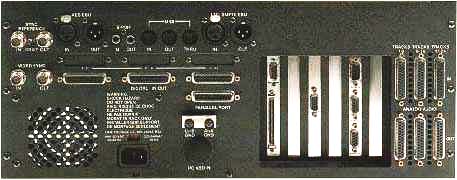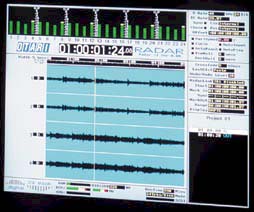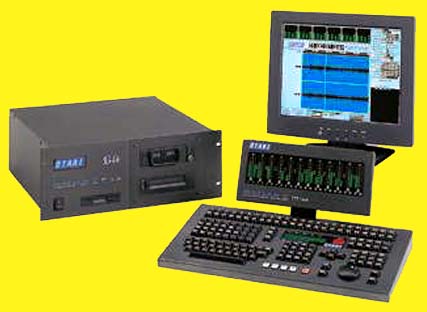SYSTEM
FEATURES & FUNCTIONS

Advancements in storage and processing
technologies: a single removable hard drive
provides record time of over 40 minutes of 24-bit,
24-track audio from a 9 GB drive.
Extended record
and playback times are available by simply hooking
up multiple drives via the unit's external SCSI
port.
Multiple RADAR
IIs can be linked together using RADAR Link. The
enhanced RE-8 II Controller provides track arming
and optional metering of up to 48 tracks of digital
audio.
RADAR II locks
to all standard SMPTE/EBU timecode rates and
formats, video composite (NTSC and PAL) and word
clock.
Sampling rate is
variable between 32 and 48 kHz. Varispeed, MIDI I/O
and RS-422 serial control are also standard, makin
interfacing RADAR II with existing studio equipment
an easy operation.
RADAR II's Rear
Panel contains the various analog and digital I/O
connectors, MIDI In/Out, word-clock and sync ports,
plus RADAR®View connections.
Other Key
Features:
24 A-to-D and
24-bit D-to-A Converters for enhanced audio
record/replay quality.
24-Bit
Architecture Throughout, to maintain sonic fidelity
from multichannel analog/digital input to
multichannel analog/digital output.
24-Track Digital
I/O using 25-pin D-Sub connectors, for simple
system hookup.
48-Track RE-8 II
Controller/Remote with Removable Meterbridge, to
simplify system operation and level
display.
8mm Exabyte tape
for fast system back up.
16- or 24-Bit
operation, for compatibility with earlier
systems.
Compatibility
with older-generation RADAR I systems, to allow
users to migrate to 24-bit operation.
Multiple Project
Management, to streamline inload and offload of
sessions.
User Definable
Macro Keys, for the speed user expect from
random-access record and playback.
RADAR II software
update: released v2.12

Feature
enhancements in v2.12 include Waveform Display, the
implementation of DVD-RAM, Mammoth, and AIT Backup
drives, Seagate and IBM 9GB, 18GB, and 36GB
qualified SCSI hard drives, Selectable Digital
Inputs, Macro Keys, Auto Offset Calculate, and
improved Backup and Restore implementation.
A hardware
upgrade is required in order to run Waveforms, and
includes a faster Pentium processor, 64MB of RAM,
and new key caps for your RE-8II remote. The full
upgrade kit, with release notes, can be obtained
directly from Otari.
V2.12 Feature
Enhancements in Detail
The revision
includes several useful new featuresIn addition,
Otari has announced the qualification of three new
hard drives for use with the RADAR II: Seagate's
ST39103LW 9GB and ST318203LW 18 GB drives, IBM's
DMVS18V 18 GB drive, and IBM's DMVS-36U 36 GB
drive.
36 GB represents
168 minutes of 24-track, 24-bit
recording.
The new revision
enables the display of waveforms for audio levels
above the "Wave Noise Floor" defined in the Project
and Preference menus. These can be viewed in detail
using new ZOOM and SCROLL keys defined for the
RE8-II remote. There is also a "ZOOM SOLO" feature
that allows zooming to non-sequential track
groupings. This feature can be used independently
of track soloing, or the "Solo Zoom Audio"
preference can be enabled. In this mode, only
tracks selected for Zoom Solo will be heard.
A new menu item
under the DIG I/O menu routing section offers
digital track assignment. This enables the user to
select which tracks to input from the multichannel
digital inputs (TDIF or AES-Multi). Tracks that are
not selected as digital will remain as analog
inputs. The user can set all tracks to digital by
choosing the ALL option, or select specific tracks
by choosing SELECT and then using the Track Arm
buttons.
A new
internal/external SMPTE display mode has been
included for use when the RADAR II is controlled by
an external transport such as a VCR or audio deck.
In this mode, the first line of the display shows
the RADAR's internal time as usual, while the
second line displays timecode plus the sync offset.
This latter value also appears on the RADAR view
screen as the main time counter. If the sync offset
is set to the difference between the RADAR and
external timecode values, the displayed value will
correspond to the time code of the external device.
A new display button has been added to the RE-8II
controller to access this feature.
The existing
"auto reclaim" button has been replaced by a
"capture" button, which reads the incoming
timecode, compares it to RADAR internal time, and
sets the sync offset accordingly. If fine-tuning is
required, an offset calculator can be called up to
manipulate the time code values as required.
The new software
revision includes the features added in v 2.06,
which included the ability to undo IN and OUT
markers, and the automatic error-checking feature
that warns users if a damaged project is loaded and
allows the errors to be fixed or logged for later
action.
Future RADAR II
updates include an AES/EBU (24 channel)
Multichannel card; MADI; 96k Turbo card; Remote
back-up station and a RAID Array.
Future RADAR II
updates include an AES Multichannel card; MADI; 96k
Turbo card; Exabyte Mammoth Drives; Remote back-up
station and a RAID Array.
Video Sync
Reference &emdash;Connections for video sync
reference, with 75-ohm terminator.
AES/EBU
Connections &emdash; Connections for two track
digital audio transfers with AES/EBU-compatable
systems.
S/P DIF I/O Connections &emdash; Connections for
two-track digital audio transfers to other
SPDIF-compatable systems.
MIDI Connections &emdash; connections for MTC
interface with MIDI-compatable system
Time Code
Connections &emdash; Connections to external time
code for external SMPTE/EBU format.
Digital I/O Sync (Word Clock) &emdash; Connections
for video sync reference, with 75-ohm terminator.
TDIF
Connections &emdash; Connections to multi-track
audio recorders/mixers and other TDIF-compatable
systems, in groups of eight channels.
Controller
& SCSI Connections &emdash; Connections to RE-8
controller (upper) and external SCSI-compatable
hard drives for extended record time.
VGA CONNECTOR &emdash; Connection to an external
VGA compatable monitor.
RADARLINK & 9-pin Serial Connectors &emdash;
Connections to RADARLINK (upper) and 9-pin Serial
Controllers (lower).
Analog
Inputs &emdash; 12 Analog connections for up to 24
tracks of balanced analog inputs (+4 dBv) in groups
of eight tracks each per DB-25 port.
Analog
Outputs &emdash; Connection for up to 24 tracks of
balanced analog outputs (+4 dBv) in groups of eight
tracks each per DB-25 port.



